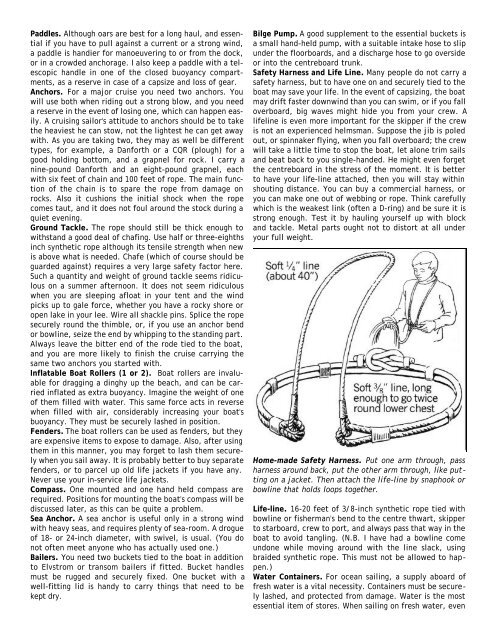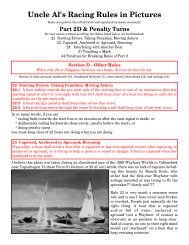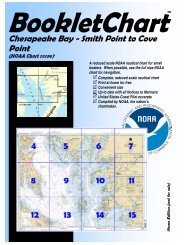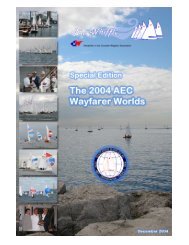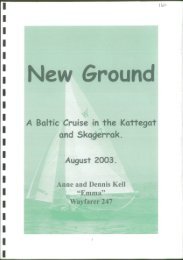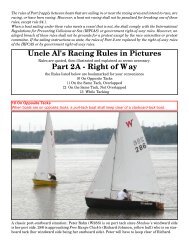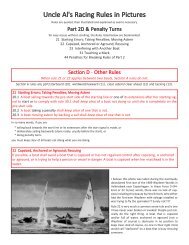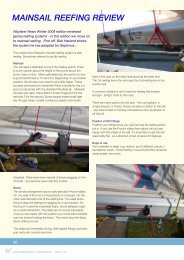Contents - Wayfarer Institute of Technology
Contents - Wayfarer Institute of Technology
Contents - Wayfarer Institute of Technology
Create successful ePaper yourself
Turn your PDF publications into a flip-book with our unique Google optimized e-Paper software.
Paddles. Although oars are best for a long haul, and essential<br />
if you have to pull against a current or a strong wind,<br />
a paddle is handier for manoeuvering to or from the dock,<br />
or in a crowded anchorage. I also keep a paddle with a telescopic<br />
handle in one <strong>of</strong> the closed buoyancy compartments,<br />
as a reserve in case <strong>of</strong> a capsize and loss <strong>of</strong> gear.<br />
Anchors. For a major cruise you need two anchors. You<br />
will use both when riding out a strong blow, and you need<br />
a reserve in the event <strong>of</strong> losing one, which can happen easily.<br />
A cruising sailor's attitude to anchors should be to take<br />
the heaviest he can stow, not the lightest he can get away<br />
with. As you are taking two, they may as well be different<br />
types, for example, a Danforth or a CQR (plough) for a<br />
good holding bottom, and a grapnel for rock. I carry a<br />
nine-pound Danforth and an eight-pound grapnel, each<br />
with six feet <strong>of</strong> chain and 100 feet <strong>of</strong> rope. The main function<br />
<strong>of</strong> the chain is to spare the rope from damage on<br />
rocks. Also it cushions the initial shock when the rope<br />
comes taut, and it does not foul around the stock during a<br />
quiet evening.<br />
Ground Tackle. The rope should still be thick enough to<br />
withstand a good deal <strong>of</strong> chafing. Use half or three-eighths<br />
inch synthetic rope although its tensile strength when new<br />
is above what is needed. Chafe (which <strong>of</strong> course should be<br />
guarded against) requires a very large safety factor here.<br />
Such a quantity and weight <strong>of</strong> ground tackle seems ridiculous<br />
on a summer afternoon. It does not seem ridiculous<br />
when you are sleeping afloat in your tent and the wind<br />
picks up to gale force, whether you have a rocky shore or<br />
open lake in your lee. Wire all shackle pins. Splice the rope<br />
securely round the thimble, or, if you use an anchor bend<br />
or bowline, seize the end by whipping to the standing part.<br />
Always leave the bitter end <strong>of</strong> the rode tied to the boat,<br />
and you are more likely to finish the cruise carrying the<br />
same two anchors you started with.<br />
Inflatable Boat Rollers (1 or 2). Boat rollers are invaluable<br />
for dragging a dinghy up the beach, and can be carried<br />
inflated as extra buoyancy. Imagine the weight <strong>of</strong> one<br />
<strong>of</strong> them filled with water. This same force acts in reverse<br />
when filled with air, considerably increasing your boat's<br />
buoyancy. They must be securely lashed in position.<br />
Fenders. The boat rollers can be used as fenders, but they<br />
are expensive items to expose to damage. Also, after using<br />
them in this manner, you may forget to lash them securely<br />
when you sail away. It is probably better to buy separate<br />
fenders, or to parcel up old life jackets if you have any.<br />
Never use your in-service life jackets.<br />
Compass. One mounted and one hand held compass are<br />
required. Positions for mounting the boat's compass will be<br />
discussed later, as this can be quite a problem.<br />
Sea Anchor. A sea anchor is useful only in a strong wind<br />
with heavy seas, and requires plenty <strong>of</strong> sea-room. A drogue<br />
<strong>of</strong> 18- or 24-inch diameter, with swivel, is usual. (You do<br />
not <strong>of</strong>ten meet anyone who has actually used one.)<br />
Bailers. You need two buckets tied to the boat in addition<br />
to Elvstrom or transom bailers if fitted. Bucket handles<br />
must be rugged and securely fixed. One bucket with a<br />
well-fitting lid is handy to carry things that need to be<br />
kept dry.<br />
Bilge Pump. A good supplement to the essential buckets is<br />
a small hand-held pump, with a suitable intake hose to slip<br />
under the floorboards, and a discharge hose to go overside<br />
or into the centreboard trunk.<br />
Safety Harness and Life Line. Many people do not carry a<br />
safety harness, but to have one on and securely tied to the<br />
boat may save your life. In the event <strong>of</strong> capsizing, the boat<br />
may drift faster downwind than you can swim, or if you fall<br />
overboard, big waves might hide you from your crew. A<br />
lifeline is even more important for the skipper if the crew<br />
is not an experienced helmsman. Suppose the jib is poled<br />
out, or spinnaker flying, when you fall overboard; the crew<br />
will take a little time to stop the boat, let alone trim sails<br />
and beat back to you single-handed. He might even forget<br />
the centreboard in the stress <strong>of</strong> the moment. It is better<br />
to have your life-line attached, then you will stay within<br />
shouting distance. You can buy a commercial harness, or<br />
you can make one out <strong>of</strong> webbing or rope. Think carefully<br />
which is the weakest link (<strong>of</strong>ten a D-ring) and be sure it is<br />
strong enough. Test it by hauling yourself up with block<br />
and tackle. Metal parts ought not to distort at all under<br />
your full weight.<br />
Home-made Safety Harness. Put one arm through, pass<br />
harness around back, put the other arm through, like putting<br />
on a jacket. Then attach the life-line by snaphook or<br />
bowline that holds loops together.<br />
Life-line. 16-20 feet <strong>of</strong> 3/8-inch synthetic rope tied with<br />
bowline or fisherman's bend to the centre thwart, skipper<br />
to starboard, crew to port, and always pass that way in the<br />
boat to avoid tangling. (N.B. I have had a bowline come<br />
undone while moving around with the line slack, using<br />
braided synthetic rope. This must not be allowed to happen.)<br />
Water Containers. For ocean sailing, a supply aboard <strong>of</strong><br />
fresh water is a vital necessity. Containers must be securely<br />
lashed, and protected from damage. Water is the most<br />
essential item <strong>of</strong> stores. When sailing on fresh water, even


